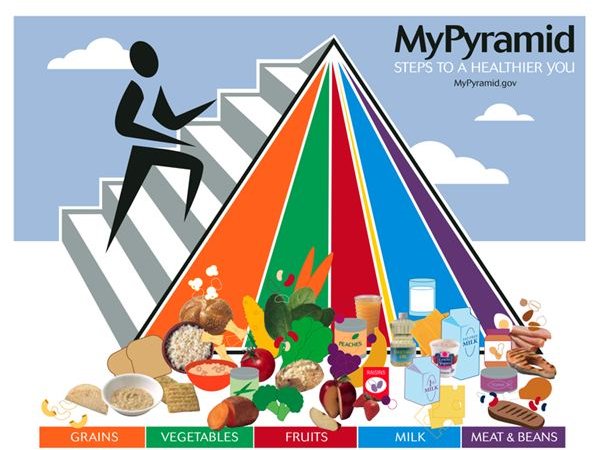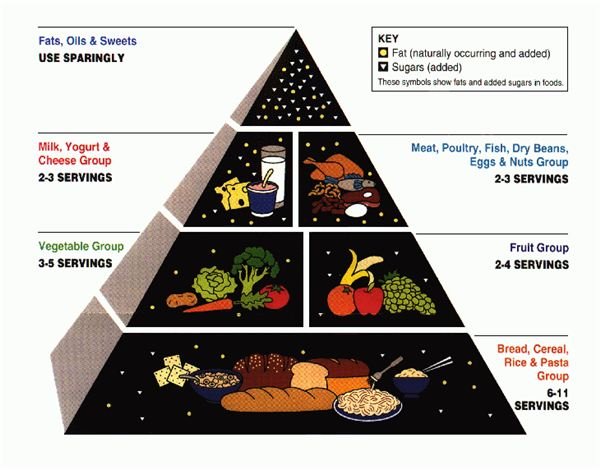What are the Recent Changes in the Food Pyramid? Learn the Differences and Create Your Own Customizable Plan
Introduction
The Food Pyramid had its beginning in the 1970s, though nutritional guidelines have been given by the government since 1894. This first incarnation as a pyramid has undergone some changes, with the most recent being in 2005. What are the recent changes in the food pyramid? A new design and a new element are just two of them.
Previous Food Pyramid Guidelines
The former food pyramid design was easy to understand and had fairly specific guidelines. The bottom portion of the pyramid was the grains group, titled, “Bread, Cereal, Rice and Pasta Group.” The recommendation was for six to eleven servings per day.
The next level up was split between the Vegetable Group and the Fruit Group. Vegetables were recommended in an amount of three to five servings daily, while the Fruit Group came with a recommendation of two to four servings each day.
The next level up, the second from the top, was divided between dairy and protein. The Milk, Yogurt and Cheese group was recommended for two to three daily servings. The Meat, Poultry, Fish, Dry Beans, Eggs and Nuts Group was recommended for two to three servings daily.
At the very top of the pyramid was a small section for Fats, Oils and Sweets. The recommendation for this group was to “Use Sparingly.”
Often accompanying Food Guide Pyramid information was information about portion sizes as well as recommendations for men, women, teens and young children.
Current Food Pyramid Guidelines

The current pyramid is called “MyPyamid” and is designed very differently from the previous pyramid because, “One size doesn’t fit all.”
This format is still in the shape of a pyramid, with colored bands streaming down the front in varying sizes. On the far left side is a set of stairs with a purple figure climbing them.
Starting from the left, the first colored band is orange. This band represents Grains. The recommendation is to “eat at least 3 ounces of whole grain bread, cereal, crackers, rice, or pasta every day.”
The next band is green and it represents Vegetables. The recommendations for this group are simply to “eat more” dark green vegetables, orange vegetables, dry beans and peas.
Fruits make up the next band, which is red in color. For this group, the advice is to eat a variety of fruit and to go easy on fruit juices. It notes that you can choose from any type of fruit: fresh, frozen, canned and dried.
The second to last band is blue and for “Milk” (not “Dairy”), though under the name it does mention you should “get your calcium-rich foods.” The advice for this group is to consume low-fat and fat-free selections as well as to utilize lactose-free or other calcium sources if you cannot or do not drink milk.
The final band is purple and is for Meats and Beans. The advice is to “Go lean on protein.” Other advice includes how to cook it (bake, broil or grill) as well as varying choices with the inclusion of “more” fish, beans, nuts, seeds and peas.
The person on the steps also represents something in this pyramid. This “group” is Physical Activity. The recommendations are that adults should be active for at least 30 minutes most days of the week; teenagers and children should be physically active for twice that, every day (or most days).
Summary
The answers to “What are the recent changes in the food pyramid?” can be disappointing. The non-specifics in this latest incarnation of the food pyramid along with the widespread criticism of it could make its use less-than-helpful in formulating a healthy eating plan. However, the MyPyramidPlan tool on the official site can be used to create a custom plan, based on this pyramid as well as things like age, gender, weight, height and level of physical activity.
Further Reading
The Top 5 Effects of Good Nutrition
References
MyPyramid. United States Department of Agriculture. https://www.mypyramid.gov/
The Food Guide Pyramid. https://www.nal.usda.gov/fnic/Fpyr/pmap.htm
MyPyramid for Kids. United States Department of Agriculture. https://www.mypyramid.gov/kids/index.html
New Food Pyramid Scheme Unveiled. Lloyd de Vries. January 12, 2005. https://www.cbsnews.com/stories/2005/01/12/health/main666375.shtml
The Food Pyramid: Its History, Purpose and Effectiveness. Jaye Lewis. https://health.learninginfo.org/food-pyramid.htm
Image Credits
Food Pyramid image from U.S.D.A. Public Domain. Wikimedia Commons. https://commons.wikimedia.org/wiki/File:USDA_Food_Pyramid.gif
MyPyramid Image from U.S.D.A. Public Domain. Wikimedia Commons. https://commons.wikimedia.org/wiki/File:MyPyramid1.png
